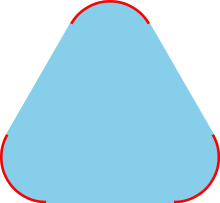Extreme point (original) (raw)
From Wikipedia, the free encyclopedia
Point not between two other points
A convex set in light blue, and its extreme points in red.
In mathematics, an extreme point of a convex set S {\displaystyle S} 



Throughout, it is assumed that X {\displaystyle X} 
For any p , x , y ∈ X , {\displaystyle p,x,y\in X,} 






If K {\displaystyle K} 











Generalizations
If S {\displaystyle S} 








The midpoint[2] of two elements x {\displaystyle x} 


For any elements x {\displaystyle x} 

![{\displaystyle [x,y]=\{tx+(1-t)y:0\leq t\leq 1\}}](https://wikimedia.org/api/rest_v1/media/math/render/svg/3810395f30e967d0e6385a1afd21e37047683212)










The closed interval [ x , y ] {\displaystyle [x,y]} ![{\displaystyle [x,y]}](https://wikimedia.org/api/rest_v1/media/math/render/svg/1b7bd6292c6023626c6358bfd3943a031b27d663)




![{\displaystyle [x,y]\subseteq K.}](https://wikimedia.org/api/rest_v1/media/math/render/svg/4f10564af0cf9b6ffeba5a085ed3ce0892d1e1ed)
If K {\displaystyle K} 








If a < b {\displaystyle a<b} 


![{\displaystyle [a,b].}](https://wikimedia.org/api/rest_v1/media/math/render/svg/3ba5cb29655f824ce80a0b6a32d9326d0e8742cd)




The extreme points of the closed unit disk in R 2 {\displaystyle \mathbb {R} ^{2}} 
The perimeter of any convex polygon in the plane is a face of that polygon.[2]The vertices of any convex polygon in the plane R 2 {\displaystyle \mathbb {R} ^{2}} 
An injective linear map F : X → Y {\displaystyle F:X\to Y} 


The extreme points of a compact convex set form a Baire space (with the subspace topology) but this set may fail to be closed in X . {\displaystyle X.} 
Krein–Milman theorem
[edit]
The Krein–Milman theorem is arguably one of the most well-known theorems about extreme points.
These theorems are for Banach spaces with the Radon–Nikodym property.
A theorem of Joram Lindenstrauss states that, in a Banach space with the Radon–Nikodym property, a nonempty closed and bounded set has an extreme point. (In infinite-dimensional spaces, the property of compactness is stronger than the joint properties of being closed and being bounded.[4])
Theorem (Gerald Edgar) — Let E {\displaystyle E} 










Edgar’s theorem implies Lindenstrauss’s theorem.
A closed convex subset of a topological vector space is called strictly convex if every one of its (topological) boundary points is an extreme point.[6] The unit ball of any Hilbert space is a strictly convex set.[6]
More generally, a point in a convex set S {\displaystyle S} 













The finite-dimensional Krein–Milman theorem, which is due to Minkowski, can be quickly proved using the concept of k {\displaystyle k} 















- Choquet theory – Area of functional analysis and convex analysis
- Bang–bang control[7]
- ^ Saltzman, Matthew. "What is the difference between corner points and extreme points in linear programming problems?".
- ^ a b c d e f g h i j Narici & Beckenstein 2011, pp. 275–339.
- ^ a b Grothendieck 1973, p. 186.
- ^ Artstein, Zvi (1980). "Discrete and continuous bang-bang and facial spaces, or: Look for the extreme points". SIAM Review. 22 (2): 172–185. doi:10.1137/1022026. JSTOR 2029960. MR 0564562.
- ^ Edgar GA. A noncompact Choquet theorem. Proceedings of the American Mathematical Society. 1975;49(2):354–8.
- ^ a b Halmos 1982, p. 5.
- ^ Artstein, Zvi (1980). "Discrete and continuous bang-bang and facial spaces, or: Look for the extreme points". SIAM Review. 22 (2): 172–185. doi:10.1137/1022026. JSTOR 2029960. MR 0564562.
- Adasch, Norbert; Ernst, Bruno; Keim, Dieter (1978). Topological Vector Spaces: The Theory Without Convexity Conditions. Lecture Notes in Mathematics. Vol. 639. Berlin New York: Springer-Verlag. ISBN 978-3-540-08662-8. OCLC 297140003.
- Bourbaki, Nicolas (1987) [1981]. Topological Vector Spaces: Chapters 1–5. Éléments de mathématique. Translated by Eggleston, H.G.; Madan, S. Berlin New York: Springer-Verlag. ISBN 3-540-13627-4. OCLC 17499190.
- Paul E. Black, ed. (2004-12-17). "extreme point". Dictionary of algorithms and data structures. US National institute of standards and technology. Retrieved 2011-03-24.
- Borowski, Ephraim J.; Borwein, Jonathan M. (1989). "extreme point". Dictionary of mathematics. Collins dictionary. HarperCollins. ISBN 0-00-434347-6.
- Grothendieck, Alexander (1973). Topological Vector Spaces. Translated by Chaljub, Orlando. New York: Gordon and Breach Science Publishers. ISBN 978-0-677-30020-7. OCLC 886098.
- Halmos, Paul R. (8 November 1982). A Hilbert Space Problem Book. Graduate Texts in Mathematics. Vol. 19 (2nd ed.). New York: Springer-Verlag. ISBN 978-0-387-90685-0. OCLC 8169781.
- Jarchow, Hans (1981). Locally convex spaces. Stuttgart: B.G. Teubner. ISBN 978-3-519-02224-4. OCLC 8210342.
- Köthe, Gottfried (1983) [1969]. Topological Vector Spaces I. Grundlehren der mathematischen Wissenschaften. Vol. 159. Translated by Garling, D.J.H. New York: Springer Science & Business Media. ISBN 978-3-642-64988-2. MR 0248498. OCLC 840293704.
- Köthe, Gottfried (1979). Topological Vector Spaces II. Grundlehren der mathematischen Wissenschaften. Vol. 237. New York: Springer Science & Business Media. ISBN 978-0-387-90400-9. OCLC 180577972.
- Narici, Lawrence; Beckenstein, Edward (2011). Topological Vector Spaces. Pure and applied mathematics (Second ed.). Boca Raton, FL: CRC Press. ISBN 978-1584888666. OCLC 144216834.
- Robertson, Alex P.; Robertson, Wendy J. (1980). Topological Vector Spaces. Cambridge Tracts in Mathematics. Vol. 53. Cambridge England: Cambridge University Press. ISBN 978-0-521-29882-7. OCLC 589250.
- Rudin, Walter (1991). Functional Analysis. International Series in Pure and Applied Mathematics. Vol. 8 (Second ed.). New York, NY: McGraw-Hill Science/Engineering/Math. ISBN 978-0-07-054236-5. OCLC 21163277.
- Schaefer, Helmut H.; Wolff, Manfred P. (1999). Topological Vector Spaces. GTM. Vol. 8 (Second ed.). New York, NY: Springer New York Imprint Springer. ISBN 978-1-4612-7155-0. OCLC 840278135.
- Schechter, Eric (1996). Handbook of Analysis and Its Foundations. San Diego, CA: Academic Press. ISBN 978-0-12-622760-4. OCLC 175294365.
- Trèves, François (2006) [1967]. Topological Vector Spaces, Distributions and Kernels. Mineola, N.Y.: Dover Publications. ISBN 978-0-486-45352-1. OCLC 853623322.
- Wilansky, Albert (2013). Modern Methods in Topological Vector Spaces. Mineola, New York: Dover Publications, Inc. ISBN 978-0-486-49353-4. OCLC 849801114.
